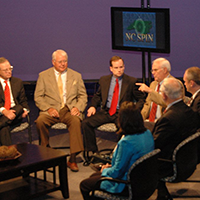NC Map Act is unfair to landowners in highway paths
Published October 9, 2014
Editorial by News and Observer, October 8, 2014.
The Map Act is a North Carolina law intended to clear the way for new highways. But a more accurate name would be Map, Don’t Act.
The law has locked thousands of property owners in Wake, Johnston, Forsyth, Cumberland, Cleveland and other counties in a real-estate limbo. The Map Act allows the state to designate pathways for future road extensions and block any development in the pathways indefinitely.
Property owners who go through the expense of obtaining a site plan and building permit can force the state to allow the development or pay them for their land, but the state has three years to decide on the request. Many smaller property owners can’t afford the expense of a plan and a permit and even if they can, a potential buyer may move on or the market may change during the three-year wait.
The state’s inaction has created an unfair and costly mess for landowners unlucky enough to have their properties fall within the state’s prospective routes. The problem has been particularly acute in Winston-Salem, where a proposed loop has lingered unbuilt for nearly two decades, and parts of Wake County where completion of the last leg of the Outer Loop has bogged down.
News & Observer transportation writer Bruce Siceloff recently reported on the real estate gridlock caused by invisible roads. He explained the quandary faced by Tawfiq Abdel-Ghani and his brother-in-law Suleman Asad, who bought 25 acres of farmland on Sunset Lake Road near Holly Springs 20 years ago.
In 1997, the N.C. Department of Transportation drew a 1,000-foot-wide stripe on the map for extending the Outer Loop that includes their land and essentially froze its use. The owners can’t develop the land, but they must continue paying taxes on it, albeit at a lower rate.
Lower cost to state
The state benefits from the Map Act because it forces the land needed for a highway to stay undeveloped or lightly developed, meaning the state won’t have to condemn expensive residential and commercial developments later on. That’s a reasonable precaution so long as the state buys the land promptly after the construction corridor is designated. But DOT’s decades-long delay is effectively a state taking the land’s value without fair compensation.
Attorney Matthew Bryant of Winston-Salem represents Abdel-Ghani and Asad and more than 100 other property owners caught in what he calls the “DOT ghetto.” They can’t sell their land at a fair price and they can’t develop it either. And when owners do get an offer from DOT, it’s often a take-it-or-leave-it figure.
“They don’t negotiate on a price, they tell you what the price is,” Bryant says.
In some cases, the DOT’s delays are outlasting the owners. “I’ve had three clients die. Others are sick and dying,” Bryant says.
DOT spokesman Steve Abbott says the delays are not all DOT’s fault. Highways require extensive environmental studies ahead of construction and, in the case of the Outer Loop, local resistance to one proposed path delayed the full evaluation of all options as required by the federal government.
Constitutional challenge
Whatever the reason, justice delayed is justice denied, and clearly that’s the effect on property owners in the path of some proposed state routes. Bryant makes that argument in a lawsuit challenging the constitutionality of the Map Act. The case is before the N.C. Court of Appeals.
State taxpayers benefit from the Map Act’s making right-of-way cheaper to purchase and the desiginated corridors help with local planning. But those benefits shouldn’t come at the expense of property owners who happen to be in the way. The appellate court should strike down the Map Act’s open-ended hold on land and require that owners of land in designated highway corridors be promptly and fairly compensated.
The situation as it is creates more than a headache for property owners in the corridors. It disrupts real estate markets and deprives local governments of the tax revenue that would flow from a fuller use of the land.







